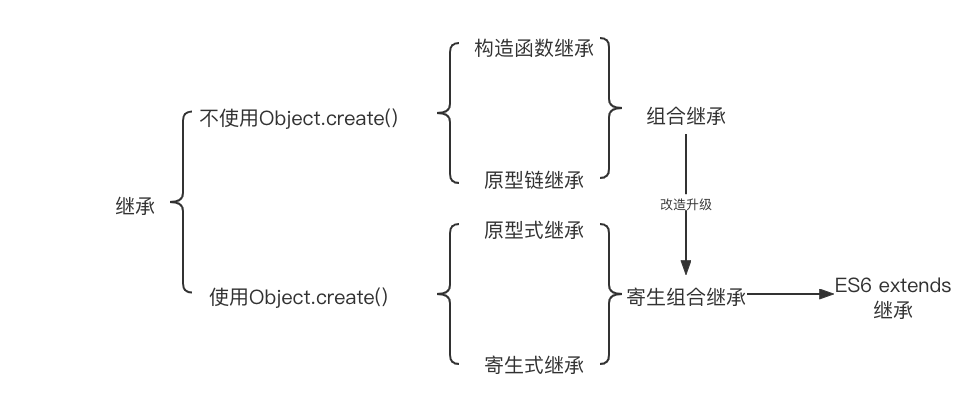写在前面
我们知道面向对象的编程语言中都会有继承,而且在各种语言中充当着至关重要的角色,但是继承是什么?又有多少种继承的方式?常见的又有哪些呢?对于js继承有更深层次的理解,能够在开发中应对自如。
所谓继承,继承是面向对象的,使用这种方式能够更好的对代码的复用,能够缩短开发周期、提升开发效率。
那么我们带着两个问题阅读文章,在文章解决这些疑惑:
- JS继承到底有多少种继承方式?
- ES6中的extends关键字是使用哪种继承方式实现的?
一、继承的概念
我们知道一个人继承祖业,可以将父辈所有的物质基础继承过来,但是自己作为主体又有自己的其它能力和特性。同样的汽车作为一个大类,生产轿车、跑车、面包车等,都具有汽车四个轮子加发动机的特性,但各自具有自己独特的特性,比如五菱宏光可以在秋名山飙车成为车神。
因此,继承可以使得子类具有父类的各种方法和属性。
常见的继承方式有:
- 原型链继承
- 构造函数继承
- 组合继承
- 原型链继承
- 寄生式继承
- 寄生组合式继承
二、继承
2.1 原型链继承
原型链继承是比较常见的继承方式之一,其中涉及的构造函数、原型和实例:
- 每个构造函数都有一个原型对象
- 原型对象又包含一个指向构造函数的指针
- 实例则包含一个原型对象的指针
function Person(){this.name = "person";this.abilities = ["吃饭","睡觉","打豆豆"];}function Student(){this.study = ["语文","数学","英语"];}Student.prototype = new Person();console.log(new Student());
我们可以看到Student类已经继承了Person类的所有特性:
但是,我们注意到:当使用同一个对象创建实例的时候,内存空间是共享的,当一个发生变化的时候,另外一个也会随之变化。
function Person(){this.name = "person";this.abilities = ["吃饭","睡觉","打豆豆"];}function Student(){this.study = ["语文","数学","英语"];}Student.prototype = new Person();const stu1 = new Student();const stu2 = new Student();stu1.abilities.push("走路");console.log(stu1.abilities,stu2.abilities);
我们看到stu1和stu2都是由Student对象进行创建的两个实例,当改变stu1的值,stu2的值也随之改变了。
2.2 构造函数继承(借助call)
构造函数继承可以很好的解决原型链继承的共享内存的弊端,但是父类原型对象中存在父类之前自己定义的方法,那么子类将无法继承这些方法,此时去使用父类方法就会报错。
构造函数继承只能继承父类实例、属性和方法,不能继承原型属性和方法。
function Person(){this.name = "person";}Person.prototype.getName = function(){return this.name;}function Student(){Person.call(this);this.study = ["语文","数学","英语"];}const stu = new Student();console.log(stu);console.log(stu.getName())
我们可以看到,打印的stu实例包含了Student对象以及父类Person所有的属性,但是要使用父类原型的方法就会报错。getName是父类Person的引用方法,不会共享内存。
2.3 组合继承(原型链继承+构造函数继承)
function Person(){this.name = "person";this.abilities = ["吃饭","睡觉","打豆豆"];}//第一次调用Person()Person.prototype.getName = function(){return this.name;}function Student(){//第二次调用Person()Person.call(this);this.study = ["语文","数学","英语"];}Student.prototype = new Person();//手动挂载构造器,指向自己的构造函数Student.prototype.constructor = Student;const stu1 = new Student();const stu2 = new Student();stu1.abilities.push("走路");console.log(stu1.abilities,stu2.abilities);//不会互相影响console.log(stu1.getName());//正常输出"person"console.log(stu2.getName());//正常输出"person"
运行得到:我们看到在stu1实例的abilities数组中追加元素,并不会影响到stu2实例的值。
我们发现使用组合式继承时,可以有效解决原型链继承和构造函数继承的缺点,但是,调用两次Person(),这就造成了性能开销,那么我们还有没有优化空间呢?
2.4 原型式继承
我们可以利用es5中的Object.create()方法进行原型式继承,从而实现对组合式继承的优化。Object.create()接收两个参数:
- 用作新对象原型的对象
- 为新对象定义额外属性的对象(可选参数)
```javascript
const person = {
name:”person”,
abilities:[“吃饭”,”睡觉”,”打豆豆”],
getName(){
} }return this.name;
const person1 = Object.create(person); person1.name = “human”; person1.abilities.push(“走路”);
const person2 = Object.create(person); person2.abilities.push(“跑步”);
console.log(person1.name); console.log(person1.name === person1.getName()); console.log(person2.name); console.log(person1.abilities); console.log(person2.abilities);
我们可以看到使用Object.create()可以实现普通对象继承,不仅可以继承属性,还能继承方法。但是也有缺点:包含引用类型的属性值始终都会共享相应的值,这点跟原型链继承一样。<br /><br />修改`person1.name`的值,person2.name的值并未发生改变,并不是因为person1和person2有独立的 name 值,而是因为person1.name = 'human',给person1添加了 name 值,并非修改了原型上的 name 值。<a name="cZP1z"></a>### 2.5 寄生式继承寄生式继承:首先使用原型式继承可以获得一份目标对象的浅拷贝,然后利用这个浅拷贝的能力再进行增强,添加一些方法。寄生式继承相比于原型式继承,还是在父类基础上添加了更多方法。```javascriptfunction clone(original){const clone = Object.create(original);clone.getAbilities = function(){return this.abilities;}return clone;}const person = {name:"person",abilities:["吃饭","睡觉","打豆豆"],getName(){return this.name;}}const person1 = clone(person);console.log(person1.getName());console.log(person1.getAbilities());
2.6 寄生组合式继承
前面分析了五种常见的继承方法,现在综合所有方式的优缺点,可以进行优化改造得到寄生组合式的继承方式,这也是所有继承方式中相对最优的。
function clone(parent,child){//这里使用Object.create()可以减少组合继承中多进行一次构造函数的过程child.prototype = Object.create(parent.prototype);child.prototype.constructor = child;}function Parent(){this.name = "parent";this.abilities = ["吃饭","睡觉","打豆豆"];}Parent.prototype.getName = function(){return this.name;}function Child(){Parent.call(this);this.study = ["语文","数学","英语"];}clone(Parent,Child);Child.prototype.getStudy =function(){return this.study;}const child = new Child();console.log(child);console.log(child.getName());console.log(child.getStudy());
运行得到:
extends关键字主要用于类声明或者类表达式中,以创建一个类,该类是另一个类的子类。其中constructor表示构造函数,一个类中只能有一个构造函数,有多个会报出SyntaxError错误,如果没有显式指定构造方法,则会添加默认的 constructor方法,使用例子如下。
class Rectangle {// constructorconstructor(height, width) {this.height = height;this.width = width;}// Getterget area() {return this.calcArea()}// MethodcalcArea() {return this.height * this.width;}}const rectangle = new Rectangle(10, 20);console.log(rectangle.area);// 输出 200-----------------------------------------------------------------// 继承class Square extends Rectangle {constructor(length) {super(length, length);// 如果子类中存在构造函数,则需要在使用“this”之前首先调用 super()。this.name = 'Square';}get area() {return this.height * this.width;}}const square = new Square(10);console.log(square.area);// 输出 100
extends继承的核心代码如下,其实现和上述的寄生组合式继承方式一样。
function _inherits(subType, superType) {// 创建对象,创建父类原型的一个副本// 增强对象,弥补因重写原型而失去的默认的constructor 属性// 指定对象,将新创建的对象赋值给子类的原型subType.prototype = Object.create(superType && superType.prototype, {constructor: {value: subType,enumerable: false,writable: true,configurable: true}});if (superType) {Object.setPrototypeOf? Object.setPrototypeOf(subType, superType): subType.__proto__ = superType;}}
参考文章
- 《JavaScript常用八种继承方案》
- 《深入JavaScript继承原理》
写在最后
继承的方法很多,每个实现的方法都比较零散,需要对常见的继承方法进行一个深入系统的分析总结。


